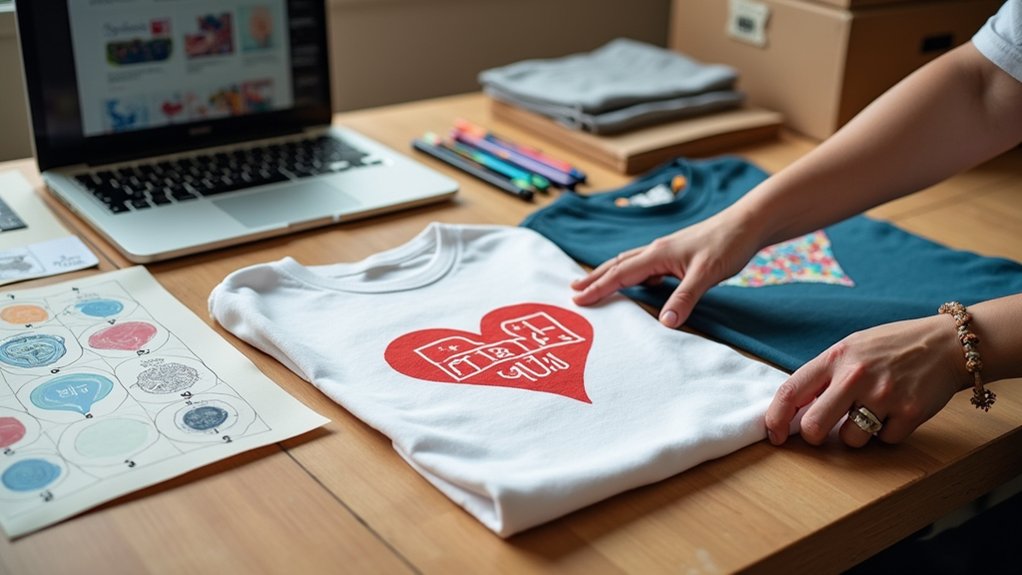Print on Demand (POD) on Etsy allows sellers to create and sell custom-designed products without managing inventory. Sellers focus on design and customer engagement while partnering with production companies to handle manufacturing and shipping. This model accommodates diverse consumer interests, offering a variety of customizable goods like apparel and home decor. Adherence to Etsy guidelines guarantees compliance and originality. Explore deeper to uncover strategies for product selection, marketing, and overcoming competitive challenges on Etsy.
Key Takeaways
- Print on Demand (POD) allows sellers to focus on designing custom products without managing inventory, with production partners handling printing and shipping.
- Sellers create unique product designs, ensuring they are original or properly licensed to comply with Etsy’s policies.
- Products include customizable items like apparel and home decor, appealing to varied consumer tastes and market trends.
- Setting up an Etsy shop involves creating an account, configuring settings, and connecting with POD partners like Printful or Printify.
- Effective product listings use high-quality images, strategic keywords, and detailed descriptions to attract potential buyers and enhance visibility.
Understanding the Print on Demand Model
The Print on Demand model on Etsy represents a transformative approach to e-commerce, allowing sellers to operate without the burden of inventory management.
In this POD business, Etsy sellers focus on designing custom products and marketing, while production partners handle printing and shipping. This division of labor enables the creation of a wide array of products, from apparel to home decor, tailored to diverse consumer tastes.
The process of selling print on demand on Etsy is streamlined, with digital downloads facilitating seamless listing creation. Access to Etsy’s expansive marketplace, with 92 million active buyers in 2023, offers significant sales opportunities.
Fundamentally, adherence to Etsy’s policies, ensuring all designs are original or properly licensed, is key to maintaining customer satisfaction and compliance.
Setting Up Your Etsy Print on Demand Shop
Starting on the journey to set up an Etsy print-on-demand shop requires a structured approach, building upon the foundational understanding of the print-on-demand model.
To sell on Etsy, one begins by creating an Etsy account and selecting “Sell on Etsy,” which involves configuring shop settings, such as language and currency. Connecting a trusted print-on-demand partner, like Printful or Printify, guarantees seamless order fulfillment.
Create an Etsy account, select “Sell on Etsy,” configure settings, and connect a trusted print-on-demand partner.
Sellers must create product listings with high-quality images, detailed descriptions, and relevant tags to attract potential buyers. Including necessary business information, such as tax details and payment methods, guarantees compliance with Etsy regulations.
Market strategies, including social media and email campaigns, are vital for driving traffic and increasing sales of custom products on this competitive platform.
Choosing the Right Products for Your Store
Selecting the ideal products for a print on demand Etsy store requires a strategic analysis of market trends and consumer preferences, with a focus on variety and eco-friendly options.
By exploring diverse categories such as apparel, home decor, and personalized stationery, sellers can cater to a broader audience while aligning with the increasing demand for sustainable products.
Utilizing tools like Google Trends and Etsy Hunt enables store owners to identify high-potential niches and optimize their offerings to remain competitive in a rapidly evolving market environment.
Product Variety Importance
Diverse product offerings play an essential role in the success of a print-on-demand Etsy store, as they enable sellers to meet the varied preferences of their customer base while enhancing their shop’s reputation.
By offering over 1,000 customizable products through platforms like Printify, Etsy sellers can address a broad spectrum of customer preferences. This variety includes high-demand items such as apparel and home decor, aligning with current market trends.
Regular updates to product listings guarantee sellers remain competitive, adapting to changing customer preferences. Utilizing tools like Etsy Hunt helps identify trending products that can be quickly added to the store.
Eco-friendly options further diversify the offerings, although not discussed here, they contribute to appealing to environmentally conscious consumers.
Eco-Friendly Options
While the shift towards sustainability is increasingly evident in consumer behavior, Etsy sellers have the opportunity to capitalize on this trend by incorporating eco-friendly product options into their print-on-demand stores.
Offering eco-friendly products, such as biodegradable phone cases and recycled apparel, meets the high demand from Etsy customers seeking sustainable materials. With over 1,000 customizable products available, sellers can enhance their store’s reputation by selecting custom products on Etsy that align with environmentally responsible shopping practices.
This approach not only taps into a niche market on Etsy but also aligns with the global movement towards sustainability. By offering products like soy candles and all-over-print clothing with vibrant dye-sublimation, sellers can attract conscientious consumers, thereby driving potential profitability in the eco-friendly segment.
Market Trends Analysis
Understanding the shift towards eco-conscious consumerism provides Etsy sellers with a strategic advantage, yet identifying high-demand products requires a thorough analysis of market trends.
Custom products, particularly in the Print on Demand sector, present lucrative opportunities for an Etsy business. Analyzing market trends reveals that custom apparel, such as t-shirts and hoodies, holds a significant market value, while personalized products in home decor reflect changing consumer preferences.
Meanwhile, custom accessories like tote bags and mugs show substantial revenue potential, aligning with customer demand for everyday personalized items. Additionally, pet products represent a niche market with a growing consumer base.
Utilizing tools like Google Trends and Etsy’s Keyword Tool can guide Etsy shop owners in selecting promising product ideas, ensuring successful selling on Etsy.
Designing Custom Products for Etsy
Crafting custom products for Etsy demands a strategic approach that integrates creativity with the practical tools offered by platforms like Printify and Printful.
Designing custom products involves applying unique designs to a variety of items, guaranteeing they adhere to Etsy policies. Sellers must focus on creating original designs or use properly licensed artwork to avoid copyright issues.
High-quality visual representation is critical; products should be displayed with detailed images at a minimum of 1,000 pixels square.
Detailed product images with a minimum of 1,000 pixels are essential for visual appeal.
Targeting niche markets through Print on Demand can be enhanced by using a keyword tool to tap into seasonal trends and popular themes. This guarantees that custom printed products resonate with potential buyers, effectively aligning with both market demands and brand aesthetics.
Managing Product Listings and Descriptions
Crafting engaging titles is a fundamental aspect of managing Etsy product listings, as they immediately capture potential buyers’ attention and set expectations.
Optimizing descriptions with clear, concise details such as materials, dimensions, and care instructions enhances customer understanding and addresses common inquiries, leading to increased trust and conversions.
Additionally, utilizing strategic keywords that resonate with customer search behaviors rather than niche industry jargon can greatly boost search visibility and attract the right audience.
Crafting Captivating Titles
When creating product listings on Etsy, it is essential to develop engaging titles that not only draw attention but also enhance visibility in search results through the strategic use of relevant keywords.
Crafting intriguing titles involves incorporating primary keywords at the beginning to optimize SEO impact while remaining concise and descriptive within the 140-160 character range.
Key strategies include:
- Utilizing specific product attributes such as color, size, and style to distinguish listings.
- Updating titles based on seasonal trends and customer feedback to sustain relevance and boost click-through rates.
- Implementing A/B testing to determine effective title formats that increase engagement and conversion rates.
Highlighting unique selling propositions within titles can set products apart from competitors, thereby enhancing the overall appeal of Etsy listings.
Optimizing Descriptions Effectively
Though often overlooked, the role of product descriptions in managing Etsy listings is essential for enhancing customer understanding and boosting sales.
To optimize descriptions, sellers should use clear, concise language that accurately details the products’ features, materials, and dimensions. This approach not only aids customer understanding but also highlights the unique selling points that differentiate items in a competitive Etsy shop environment.
Incorporating keywords naturally within descriptions improves the product listings’ visibility in Etsy’s search algorithms, thereby attracting potential buyers. Employing bullet points for key features can make information more accessible and engaging.
Additionally, sharing a compelling story about the design or creation process can emotionally engage buyers. Regular updates with seasonal trends and customer feedback guarantee continued relevance for print-on-demand items.
Utilizing Strategic Keywords
Successful Etsy sellers recognize the value of strategic keywords in maximizing product visibility and driving sales. Effective Etsy SEO practices are pivotal in enhancing product listings by aligning them with customer searches.
Sellers are advised to prioritize specific product-related keywords over general terms like “POD” or “print on demand.” This specificity guarantees listings are indexed properly and attract relevant traffic. Additionally, analyzing competitor listings provides valuable insights into successful keywords within a niche.
- Incorporate between 13-15 relevant tags per product, expanding reach.
- Adjust titles, descriptions, and tags according to seasonal trends for relevance.
- Regular updates based on customer feedback can improve sales performance.
Marketing Your Etsy Print on Demand Store
To effectively market an Etsy print on demand store, sellers must strategically harness various digital platforms and tools to enhance their visibility and attract customers.
Marketing efforts should focus on showcasing unique products through social media platforms such as Instagram, Pinterest, and Facebook, which can drive significant traffic to the Etsy store. By investing in Etsy’s promoted listings, sellers can increase their sales by up to 25%, reaching a broader audience.
Collaborating with influencers in specific niches can leverage their networks, increasing credibility and attracting new buyers.
Email marketing plays an essential role, with personalized emails leading to higher transaction rates.
Engaging in Etsy community forums and groups fosters networking and customer engagement, providing valuable insights and support to boost sales.
Overcoming Challenges in Etsy Print on Demand
Steering through the marketing environment for an Etsy print on demand store reveals more than just promotional strategies; it reveals a set of challenges that sellers must adeptly manage to sustain growth and authenticity.
In a competitive Etsy market, sellers face scrutiny over the authenticity of their custom products. Confirming original designs is crucial to avoid potential copyright claims and adhere to Etsy policies. Differentiation in a saturated market is critical for success.
- Maintain originality: Sellers must confirm designs are unique and comply with Etsy’s requirement for originality.
- Choose reliable POD providers: A partnership with quality providers safeguards customer trust and the Etsy shop’s reputation.
- Navigate competition: Differentiating products through innovation helps sellers stand out in an oversaturated environment.
These strategies are essential in overcoming challenges in the Etsy print on demand business.
Frequently Asked Questions
How Does Selling Print-On-Demand on Etsy Work?
Selling print-on-demand on Etsy involves utilizing print on demand benefits, focusing on design creation, and identifying a target audience. Effective marketing strategies, thoughtful product selection, competitive pricing models, and active customer engagement enhance order fulfillment and penetrate niche markets.
How Much Does Etsy Charge for Print-On-Demand?
Etsy fees, including listing expenses, transaction charges, and payment processing, impact sellers’ profits. Print costs and shipping fees from print-on-demand services further influence earnings. A marketing budget, customer service focus, and sales tax considerations are also essential for profitability.
Is It Worth It to Sell Prints on Etsy?
Evaluating Etsy’s market potential, sellers should consider selling strategies, competitive product pricing, and effective marketing techniques. Focusing on customer engagement, niche selection, design quality, and competition analysis enhances profit margins, while streamlined inventory management supports sustainable business growth.
How Do I Sell My Print-On-Demand Card on Etsy?
Selling print-on-demand cards on Etsy involves effective Etsy marketing, high-quality product photography, and niche targeting. Sellers should focus on customer engagement, competitive pricing strategies, efficient shipping options, seamless order fulfillment, strong brand identity, seasonal trends, and social media promotion.
Conclusion
In summary, the print on demand model on Etsy offers sellers a streamlined approach to launching a custom product business with minimal upfront investment. By carefully selecting products, crafting compelling designs, and optimizing listings, sellers can effectively capitalize on market trends. Strategic marketing and diligent management of store operations are essential for success. While challenges such as competition and production logistics exist, they can be mitigated with thoughtful planning and adaptation, ensuring a sustainable and profitable Etsy print on demand venture.




